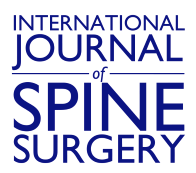Published: The Spine Journal – October 2016 – Volume 16 – Issue 10, Pages S203-S204 Abstract BACKGROUND CONTEXT: Cervical total disc replacement (TDR) has been shown as safe and effective as anterior cervical discectomy and fusion (ACDF) at both one and two levels. The relation between the number of treated levels and safety and effectiveness…
Published: Oxford Academic (Neurosurgery) – August 1, 2016 – Volume 63 – Issue CN, Page 164 Abstract INTRODUCTION: Studies suggest significant biomechanical and clinical differences exist between total disk replacement (TDR) and anterior cervical discectomy and fusion (ACDF) patients treated at multiple cervical levels. However, long-term results for treatment of multilevel cervical degenerative disc disease…
Published: JNS Spine – March 2016 – Volume 24, Pages 515 – 519 Comment On Two-level total disc replacement with Mobi-C cervical artificial disc versus anterior discectomy and fusion: a prospective, randomized, controlled multicenter clinical trial with 4-year follow-up results. [J Neurosurg Spine. 2015] Letter to the Editor: Mobi-C cervical artificial disc. [J Neurosurg Spine….
Published: JNS Spine – January 22, 2016 – Volume 40, Issue 11 Pages 759-766 Abstract OBJECTIVE: Cervical total disc replacement (TDR) has been shown in a number of prospective clinical studies to be a viable treatment alternative to anterior cervical discectomy and fusion (ACDF) for the treatment of symptomatic degenerative disc disease. In addition to…
Published: International Journal of Spine Surgery – January 1,2016 Abstract Introduction: There is increasing interest in the role of cervical total disc replacement (TDR) as an alternative to anterior cervical discectomy and fusion (ACDF). Multiple prospective randomized studies with minimum 2 year follow-up have shown TDR to be at least as safe and effective as…
Published: International Journal of Spine Surgery – November 28, 2017 Abstract BACKGROUND: Cervical total disc replacement (TDR) is an increasingly accepted procedure for the treatment of symptomatic cervical degenerative disc disease. Multiple Level I evidence clinical trials have established cervical TDR to be a safe and effective procedure in the short-term. The objective of this…
Published: Spine – June 1, 2015 – Volume 40, Issue 11 Pages 759-766 Abstract STUDY DESIGN: A prospective, randomized, multicenter Food and Drug Administration Investigation Device Exemption study using total disc replacement as surgical treatment of degenerative disc disease at 1 or 2 contiguous levels of the cervical spine. OBJECTIVE: To evaluate the safety and…
Published: Journal of Neurosurgery – January 2015 – Volume 22, Issue 1 Pages 1-111 Abstract OBJECT: The purpose of this study was to evaluate the safety and effectiveness of 2-level total disc replacement (TDR) using a Mobi-C cervical artificial disc at 48 months’ follow-up. METHODS: A prospective randomized, US FDA investigational device exemption pivotal trial…
Published: Spineuniverse – Meeting Highlights – NASS 2014 Meeting Highlight from NASS 2014 Written by Susan Spinasanta During the Cervical Disc Arthroplasty section, Robert J. Jackson, MD, FACS, FAANS presented,Subsequent Surgery Rates after Treatment with TDR or ACDF at One or Two Levels: Results from an IDE Clinical Trial with Five-Year Follow-up. Dr. Jackson stated, “this…
Published: The Spine Journal – November 1, 2014 – Volume 14 – Issue 11, Page S24 Abstract BACKGROUND CONTEXT: Few studies have presented data on multi level TDR, especially in the long-term. In order to validate the use of TDR on multiple segments, further, longer-term investigation is needed. Here we present 5-year data for the…







